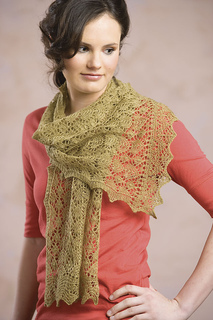patterns >  Knitted Lace of Estonia: Techniques, Patterns, and Traditions and 1 more...
Knitted Lace of Estonia: Techniques, Patterns, and Traditions and 1 more...
> Peacock Tail and Leaf Scarf






Peacock Tail and Leaf Scarf
Page 52.
Pattern Description from Knitted Lace of Estonia: “This design was inspired by a shawl in the collection of the Estonian National Museum. The shawl, knitted in wool by Frieda Terts (1911-1997), came to the Museum in 1991 from the Estonian House in Toronto, Canada. Frieda emigrated to Canada where she was very active in the Ethnographic Society in Toronto. This design is a beautiful example of the lace tradition carried on outside Estonia. The scalloped lace edging on the short ends of the scarf is separated from the main section by garter-stitch bands with punctured holes. The long sides have narrow garter-stitch bands that are pinned out at even intervals during blocking to produce scalloped edges.”
Finished Size: About 15” (38 cm) wide and 49” (124.5cm) long, after blocking.
Yarn: Fingering weight (#1 Super Fine)
Wooly West Horizons Lace Yarn (100% wool; 525 yd 480 m/50 g): willow (greenish tan), 1 skein.
Needles: Size U.S. 3 (3.25 mm). Adjust needle size if necessary to obtain the correct gauge.
Notions: Markers (m); stitch holder; removable marker or safety pin; tapestry needle.
Additional Gauge: 24 stitches and 40 rows (two pattern high) of Peacock Center chart measure about 4.75” (12 cm) wide and 5.5” (14 cm) high, after blocking.
Notes:
- “The scarf is worked in one piece from the lower edging to the end of the center section. The top edging is worked separately so its direction of knitting will match the lower edging, then the two pieces are grafted together with the Kitchener stitch.”
- “When working the top edging, you may find it helpful to mark the right side of the work with a removable marker or safety pin so you can be sure to match the right sides of the two pieces when grafting.”
- “A double strand of yarn is used for the cast-on, then a single strand is used for the remainder of the scarf.”

21 projects
stashed
32 times
- First published: October 2008
- Page created: October 23, 2008
- Last updated: September 3, 2021 …
- visits in the last 24 hours
- visitors right now




